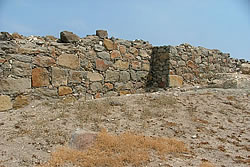 Prehistoric City Phylakopi (Pachaina)
Prehistoric City Phylakopi (Pachaina)
On the way to Pollonia on your left, you will find the discoveries of ancient Phylakopi, which are the most important settlements of the Cycladic culture and the most important city
of the prehistoric Aegean.
In this city there are remains of 2 millennia. There are traces of occupation from the beginning of the Early Bronze Age (ca. 3000 BC) to the end of the Late Bronze Age (1100 BC).
Situated in the north of the island, to give oversight capabilities in a big part of the sea, Phylakopi became a major commercial and cultural centre. Thanks to the marketing of the precious stone of obsidian, it developed rapidly and gained strength, built cyclopean walls against the invaders and was destroyed resurrected three times.
The settlement was inhabited already in 3000 BC and abandoned in 1100 BC, having gone through three historical periods. Building houses began in pre-settlement era (3200 BC – 2300 BC). In the first historical period (2300-2000 BC) the settlement is about 200 meters (large by that time in the Aegean), but does not have an organized street layout, although it has a relatively organized cemetery. Furthermore, at that time the use of stone is revealed and obsidian exports multiply, leading to the full commercial blossoming of Milos. In the second period (2000-1600 BC) walls are built to protect against any attacks, the tombs are now outside the walls, while the houses are staggered layout on the hill. In this period, ceramic art evolved particularly with clear Minoan influences and the trade relations of Milos developed further with different regions of Greece and especially Crete. This period ends with the destruction of Phylakopi probably by fire raiders and by building the third settlement, the third period of the historic city (1600 BC-1110 BC) starts. During this last period, Phylakopi has an organized, street plan complex, cyclopean fortification walls with high thickness of over 6 meters and larger homes, some of them double-decker. At the beginning of this period the impact of the Minoan culture was strong (sections of plate with the Minoan Linear A engraved were found), but the Mycenaean element slowly penetrates and finally prevails. Around 1400 a Mycenaean palace is built with many rooms and a two-room temple. Works of high art and ceramic sculpture are produced, with the largest sample being the "Lady of Phylakopi" (you can see her in the Archaeological Museum of Milos). From 1200 BC. the Aegean is recreated, known shopping streets are abandoned, while the Minoan and Mycenaean culture has waned. At that time the city of Phylakopi stops being a trade centre and starts to decline, while the trade centre and the activities are moved to the island's ancient city of Klima.
Today most of the city lies below sea level, but it is worth visiting the island to admire what has been saved of the impressive cyclopean walls of the town (which is made by volcanic stone), the Temple and the House of town . Until now numerous findings are also saved, that indicate the activities of residents of the village and a dense network of contacts, particularly with the rest of the Cyclades and Crete, while visiting the Archaeological Museum you can find wonderful examples of art pottery from the town of Phylakopi such as pottery vases, stone, clay and bronze figurines, plate Linear A, a variety of utilitarian objects and the famous "Lady of Phylakopi".
|


